By Greg Kagan, The Protomold Co. Inc.
Engineering is all about tradeoffs. If your end product has to be light, it may be difficult to make it bulletproof. On the other hand, if it’s a suit of body armor, maybe it can be made light and bulletproof, but it certainly won’t be cheap. Every choice means sacrifice. The ideal material may not come in the ideal color. It may be difficult to mold, machine, or otherwise manufacture in the desired shape. It may not fit your budget. And even if that light, sleek, sexy little device you’ve created in prototype does seem perfect in every way, it may prove otherwise when it falls off the desk and all its little lights go out.
Your task would be tough enough if all you faced were engineering decisions. But finance, production, and marketing all have their say. You can do what you want in the development lab, but production must produce those widgets by the thousands. Marketing would love to cut you some slack, but they have salespeople, distributors, and customers to answer to, not to mention competitors who are racing to reach the market ahead of you. And, of course, finance is breathing down everyone’s neck.
Sometimes it seems like your job is to explain to people why they can’t have everything on their wish lists. But with good use of resources, often you can give everyone more of what they want. Technology has provided a steady stream of productivity-enhancing capabilities like computer aided design. For engineers working in plastic, there is a prototyping process called rapid injection molding that does for physical prototyping what CAD did for drafting.

In RIM, three-axis CNC mills typically use 3D CAD data to machine aluminum molds. Aluminum is used rather than steel because it saves costs in material and production time.
Prototyping: where choices are made
Tailors know that you measure twice (or thrice) so you only have to cut once. In that same sense, prototyping is where you take the measure of a product. It is where you can make adjustments—in size, shape, structure, and material—before committing to the cost of full-scale production. It’s how you ensure parts fit and work together. It’s where you check to see that what functions in the lab will also work in the real world — that it can stand up to the heat and cold, the knocks and falls, the spills and leaks. It’s where you figure out whether manufacturing can actually make it affordably and in quantity. And, if marketing is doing its job, it’s where you find out whether customers will like it, buy it, and encourage others to do the same.
But the prototyping process itself can involve difficult tradeoffs. First, prototyping and testing take time. In the race to market, speed can make the difference between a product’s life and death. Then there’s the actual cost of prototyping; some processes are very costly, especially for parts requiring rigorous testing. Finally, there’s the eternal question of how far to push the whole development process before taking a product to market. When each additional design iteration pushes back rollout and eats up budget, you may be forced to choose between great and “good enough.”
The dilemma in plastics
Traditionally, you’ve had two options for making molded plastic prototypes. Additive rapid prototyping processes, such as stereolithography (SLA), fused deposition modeling (FDM), and selective laser sintering (SLS) produce reasonable facsimiles of a design from a CAD model. The processes are fast and inexpensive in small quantities, and the resulting parts are close to the specified size and shape. However, the finish and materials aren’t the same as those of actual production parts, severely limiting their usefulness for functional and market testing.
Traditional injection molding, on the other hand, produces production-quality parts. But it can cost tens of thousands of dollars and take weeks or months to produce a mold. It’s a gamble, since a successful prototype can go right into production, while an unsatisfactory prototype can mean long delays and budget overruns. Worse yet, having invested in the hard tooling, you may be tempted (or forced) to settle for “good enough,” putting the product at risk once it goes to market.

Drafts and slight tapers help prevent parts from damage when ejected from a mold. In some cases, RIM requires slightly more draft than needed in a traditional mold. Other slight changes in a design can ensure a better mold.
A compromise with little compromise
A third choice is rapid injection molding (RIM). RIM delivers the best of both prototype options: high speed, low cost, and real injection molded parts in a choice of production finishes and resins.
Rapid injection molding replaces highly engineered steel production molds with aluminum molds made directly from 3D CAD models by three axis CNC mills. The entire process, including molding, can be completed in days, and can cost as much as 90% less than traditional steel-based injection molding. Parts can be molded in almost any of the resins used in traditional injection molding and are similar, if not identical, in quality to steel molds. As a result, they are suitable for functional and market testing.
Because it is true injection molding, RIM is also suitable for production. Undoubtedly, large production runs—typically 10 thousand parts or more—will cost less using traditional processes. But rapid injection molding suits shorter-run production or bridge tooling, allowing production to begin while steel molds are still being made. In short, for both prototyping and short run production, rapid injection molding offers advantages over both traditional injection molding and additive rapid prototyping.
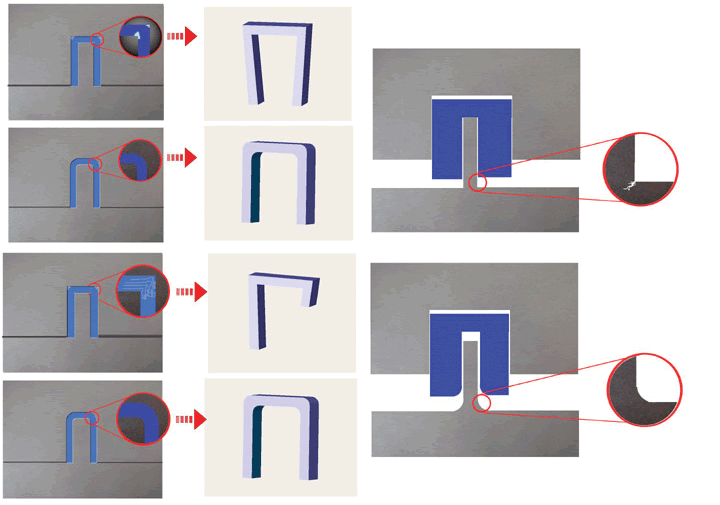
For RIM production, designs should have rounded rather than sharp corners to reduce the possibility of stresses in a finished part.
Tradeoffs
In rapid injection molding, the tool-making technique differs from traditional injection molding, placing some constraints on the design process. Naturally, any limitations that generally apply to injection molding will apply to rapid injection molding. It requires strict adherence to the principles of good plastic design, and there are some limitations peculiar to the rapid injection molding process.
With certain minor exceptions, an injection mold cannot create a space it cannot “see” from outside the mold. For example, no injection-molded part can have an enclosed hollow center, since there would be no way to remove the mold part that created the hollow. This may seem like an obvious point (and it is an extreme example), but it is worth considering since additive prototyping processes like stereolithography can create such features. As a result, a designer using only rapid prototyping could inadvertently create a prototype that cannot be reproduced by injection molding. One obvious advantage of using injection molding, rapid or otherwise, for prototyping is that, by definition, it cannot produce a prototype that cannot be manufactured by injection molding.
Rules of good design
Injection molds are filled by the movement of liquid resin within the closed mold. Uneven wall thickness can lead to premature resin cooling in thin areas, so it is important to maintain uniform wall thickness. It is possible, though expensive, to fashion traditional steel molds with conformal heating channels to slow resin cooling, allowing non-uniform wall thickness, but this is still considered a departure from ideal design. Rapid injection molding will accommodate a variety of wall thicknesses, but it does benefit from relative uniformity.
Sharp corners in a design can lead to stresses in a finished part and impede mold filling. You can prevent these problems by rounding (radiusing) corners. This guideline is somewhat more critical in rapid injection molding than in traditional injection molding, but is generally easy to accommodate in most designs.
To prevent parts from damage when ejected from the mold, draft or slightly taper the mold so it pulls away from the mold face during ejection. In some cases, RIM requires slightly more draft than would be required in a traditional mold, which rarely affects the design or integrity of the finished part.
Because resins vary in their properties, some designs are more suitable to one resin than another. For example, due to differing shrink characteristics, polyurethane may be used to produce relatively thick walls without sinking, whereas nylon would sink in the same application. Successful rapid injection molding depends on choosing appropriate resins for the design or designing to suit the resin. Traditional injection molding can sometimes, for a price, be made to accommodate less-than-ideal resins for a particular application. But with the range of resins and resin blends available today, this should rarely be necessary.
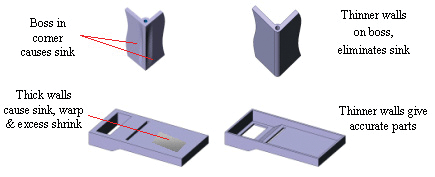
Resin characteristics may influence a design that is to underogo rapid injection molding. For example, polyurethane resins are good choices for molding relatively thick walls without shrinking or sinking, whereas nylon may sink.

CNC cutting typically does not support tall, narrow features such as tall thin ribs, or placement of fine details next to deep walls. Slight adjustments to feature thickness, adding draft, or producing tall thin walls between the core of one mold half and the cavity of the other can ease the CNC process.
Limitations specific to rapid injection molding
RIM is only practical for parts up to a certain size. The process is “rapid” because of the ease of handling molds. The aluminum molds can be moved and mounted by hand. Steel molds, on the other hand, even relatively small ones, have to be moved using large, costly equipment. The process of mounting a steel mold is cumbersome enough to make short run production expensive, while short runs are easy with rapid injection molding.
The three axis CNC cutting process used in RIM does not support very tall, narrow features—tall thin ribs, for example—or placement of very fine details next to deep walls. The long thin tools needed to make such features can reduce cutting accuracy. In most cases, slight adjustments to feature thickness, adding draft, or producing tall thin walls between the core of one mold half and the cavity of the other eliminate such fine cuts. Usually, such adjustments are easy to make and don’t impact the function of a design.
Internal undercuts are generally not supported by the rapid injection molding process. And while it supports a variety of gating methods, rapid injection molding does not support cashew or multi-drop hot runners. Due to their complexity and the required engineering time, rapid injection molding does not support stripper plates for ejection, nor, for similar reasons, does it support overmolding.
Rapid injection molding can support external undercuts using side-action cams, but the basic mold is a simple, two-part, straight pull mold. Obviously, adding cams increases cost. A large percentage of plastic parts can be produced with straight pull molds, but even where side-action cams are required, rapid injection molding is faster and less expensive than traditional injection molding.
Since rapid injection molding does entail some design limitations, you have a right to expect assistance when adapting your designs for the process. Such assistance can include evaluation of CAD models for size, suitability to a selected resin, wall uniformity, draft and other critical issues. The vendor should be able to point out potential problems so you can fix them. And, since speed and simplicity are major attributes of the RIM process, you should be able to count on speedy quoting and feedback.
The Payoff
Simply put, rapid injection molding produces superior prototypes to those produced by additive rapid prototyping, and it produces parts faster and at a fraction of the cost of traditional injection molding. While it cannot duplicate everything that the traditional process does, it has broad capabilities and distinct advantages including the ability to produce parts in mere days at a fraction of the cost. Rapid injection molding can easily handle production in volumes up to ten-thousand parts and provide bridge tooling when larger volumes are needed. And from a business point-of-view, it can significantly reduce time-to-market and support extensive testing to improve product quality. In an age of fierce global competition, those capabilities alone make it well worth a closer look.
ProtoMold
www.protomold.com
Filed Under: Factory automation

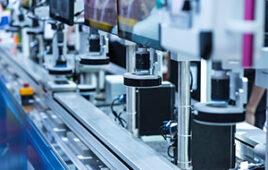
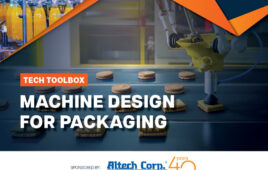
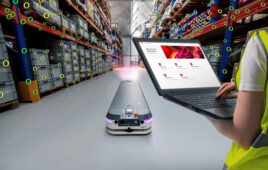
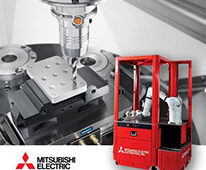
Tell Us What You Think!